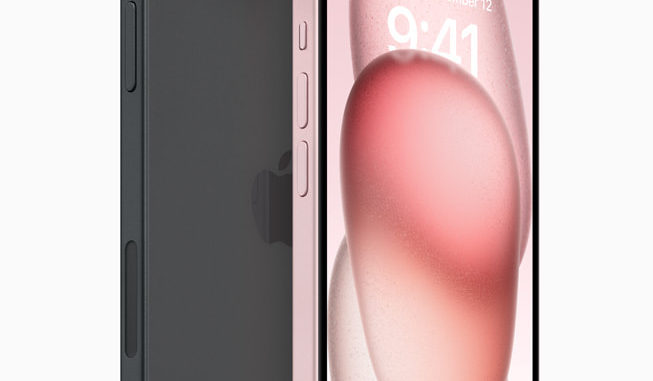
by Larry Magid
This post first appeared in the Mercury News
As it does every year around this time, Apple, on Tuesday, announced new products, including its iPhone 15 models and updates to its Apple Watch.
In a slick video presentation, Apple CEO Tim Cook and other executives talked about the features, specifications, internal workings and other details of the iPhone’s faster processors, better cameras and physical characteristics. The phone touts more rounded edges and an “action button” on its highest-end model that turns what used to be the silencing switch into a multifunction switch for things like turning on the flashlight, recording a voice memo or opening a favorite app.
They announced that their standard issue iPhone 15 and iPhone 15 Plus would now get the same A16 processor that Apple introduced last year for its Pro models. The Pro now uses the even faster A17 chip. That extra performance reminds me of Tesla’s Performance Model 3s that can go 162 miles per hour versus the paltry 145 miles per hour on its less expensive cars. To be fair, a faster chip can improve some processor-intense mobile games as Apple and some of its game developers pointed out during the presentation.
As usual, I came away initially impressed with what I saw. Apple has always had a knack for presenting its newest products in tantalizing ways, leaving the audience impressed and yearning to buy the newest version. Steve Jobs was a master at this, much like a circus barker enticing audiences to see the “greatest show on earth.”
Incremental improvements
During the early days of any technology, there is often a big year-to-year improvement. That was once true with PCs and phones as these technologies matured beyond their infancy. But like that entry-level Tesla, last year’s iPhone is more than fast enough for most users, so even though this year’s is faster, most people won’t notice much difference.
One area where the iPhone and all other mobile phones advance is in camera quality, but for most people, the cameras on last year’s phones are more than adequate. Over time, we do start to notice major improvements, but they tend to be incremental. For this reason, it’s hard to justify buying a new phone every year or even every two or three years. I know lots of people who are happy with their 4- or 5-year-old smartphones, although waiting that long does deprive you of some noticeable performance improvements, some useful new features and better cameras.
New standardized USB-C connector
Ironically, one of the biggest improvements to the new iPhones is a feature that Apple didn’t want to implement. The company is ditching its proprietary Lightning connector for charging and data transfer to USB-C. Although Apple used its presentation to tout the many benefits of USB-C, the real reason they did it was because it’s now a law in Europe, which will require all mobile phones, tablets and cameras sold in the European Union to use USB-C by the end of 2024. By 2026, that will also include laptops.
I’m sure some iPhone users will be annoyed at having to throw away their Lightning connectors and buy new USB cables for extra chargers, but I’m thrilled Apple is now joining Google and most other Android manufacturers by offering a single non-proprietary charging cable. For those who own Macs, iPads and new iPhones, it means they can use the same charger for all their devices. But that’s also now true for those of us who own Android devices, many brands of laptops and even things like Bluetooth speakers. It may not seem like a big deal, but having a USB connector is, for me, a must-have when I buy a new device. It will also reduce clutter at home, because I’ll no longer need different cables for different devices. I now have both a USB-C and a Lightning charger in my guest room because friends and family that stay over don’t all have the same type of mobile devices.
USB-C is not just for charging. It’s also a faster way to transfer data, and it can be used for headphones, speakers and other devices, so, at least in theory, it may be possible to use the same peripherals on iPhones as you use on Android phones and tablets, Macs, PCs and other devices. That’s already the case for chargers. I sometimes use my HP USB-C laptop charger on my Lenovo tablet and my Google phone. Apple is also calling this an environmental win because you’ll need few chargers and charging cables.
Pricing and new Android phones
The new iPhones will hit stores on September 22. You can pre-order as early as Friday at 5:00 a.m., PDT. Prices start at $799 for the 6.1-inch iPhone 15, $899 for the 6.7-inch iPhones 14 Plus, $999 for the iPhone Pro and $1,199 for the 6.7-inch iPhone Pro Plus.
And, if you happen to be open to getting an Android phone, know that Google will likely unveil its next generation Pixel phones and watch October 4.
[related_articles location=”left” show_article_date=”false” article_type=”automatic-primary-section”]
Larry Magid is a tech journalist and internet safety activist.